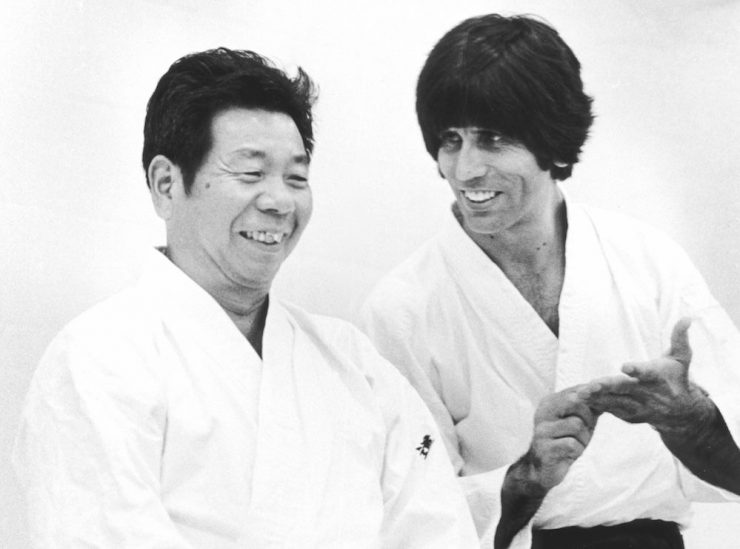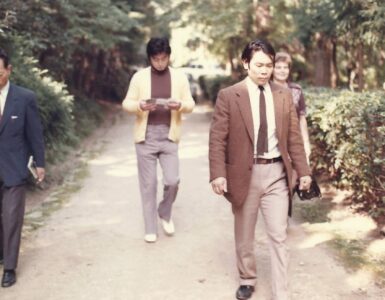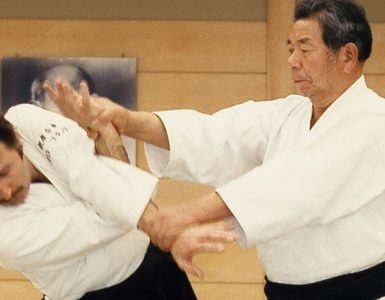In this third of a four-part series, we pick up our story at the time I was inducted into the U.S. army in October 1969 after having spent a summer practicing aikido in Tokyo. Read the second part here.
Entering the U.S. Army
 I went through basic training in Fort Ord, California and then was assigned to a radio communications school in Texas. From there, since it was the height of the Vietnam War, you might be able to guess where I was sent… to Ethiopia, of course! I spent 18 months in Asmara, a beautiful city much of which had been built by the Italians during their colonial rule of the northern part of this African nation. I worked as a French translator and also had a chance to teach aikido at the U.S. communications base where I was stationed. My students were mostly American soldiers and Italians. It was a great way to become part of the local culture and gave me experience in setting up and operating an aikido club entirely on my own.
I went through basic training in Fort Ord, California and then was assigned to a radio communications school in Texas. From there, since it was the height of the Vietnam War, you might be able to guess where I was sent… to Ethiopia, of course! I spent 18 months in Asmara, a beautiful city much of which had been built by the Italians during their colonial rule of the northern part of this African nation. I worked as a French translator and also had a chance to teach aikido at the U.S. communications base where I was stationed. My students were mostly American soldiers and Italians. It was a great way to become part of the local culture and gave me experience in setting up and operating an aikido club entirely on my own.
Following my tour of duty in Ethiopia I was sent back to the U.S. to the Defense Language Institute in Monterey, California as a French instructor. Since my work duties were light, I was able to study Japanese at the Institute where classes were given in more than 30 languages. Also, my friend Dr. Robert Frager whom I mentioned in my previous article was then an instructor at the nearby University of California at Santa Cruz. He invited me to teach there once a week and thus I was able to continue aikido practice even though at that time there was no dojo in Monterey. This continued after my discharge from the army in October 1972. I returned to the University of California as a graduate student for a brief period and taught translation courses at a private language institute in Monterey. Then in the summer of 1973 I began teaching aikido classes at a local judo school. I wanted to start a group of my own locally so I would not always have to commute such long distances to train.
Reassigned to Monterey, California
It was during the Monterey years that I began doing English translations of some Japanese-language articles on Morihei Ueshiba with a good friend and aikido student, Dr. Katsuaki Terasawa. This was done merely out of a personal interest in learning more about the founder of aikido. As it turned out, my own students and other practitioners in the Northern California area were eager to read these translations as so little was available on the life of the Ueshiba Sensei. The positive response to these articles suggested to me the idea of creating a small newsletter combining these historical translations and news about local aikido dojos.
I undertook this project and the first issue of Aiki News appeared in April 1974 as a very modest eight-page newsletter. The beginnings of the publication were not very spectacular, but the appearance of each issue carried with it a deep sense of personal satisfaction which I found extremely seductive. On a humorous note, I’ll never forget how my students would leave the dojo early or not even bother to come to practice at all when the deadline for Aiki News drew near. The reason for this was simple. We would have a folding, stapling and mailing party on the tatami after practice to finish the News. These sessions would easily last two hours so even the promise of a free copy for those who helped out seemed to be an insufficient inducement. My solution to this organized conspiracy was to keep secret the date of publication and hurry on to the tatami before the students left with boxes full of printed pages, staplers, envelopes, etc. and attempt to enlist everyone’s aid!
It was shortly after publication of the first issue of Aiki News that Koichi Tohei Sensei made his decision to leave the Aikikai. I attended a meeting in Los Angeles in May of 1974. 40 or 50 instructors from all over California and the southwestern states were present and Tohei Sensei explained the reasons for his action. There was a conflict over teaching methodology as Tohei, as the shihan bucho, wished to have the Aikikai adopt his ki approach to aikido. Many of us had ties both to Tohei and the Aikikai and having to choose between the two sides was a gut-wrenching decision. This situation also had strong repercussions all over America and it split aikido into two opposing camps. Yesterday’s friends became today’s enemies. I regarded this division in the aikido world to be artificial and remember not being able to openly participate in Ki no Kenkyukai seminar because I was now officially on the Aikikai side.
I returned to the University of California as a graduate student for a brief period and taught translation courses at a private language institute in Monterey. Then in the summer of 1973 I began teaching aikido classes at a local judo school. I wanted to start a group of my own locally so I would not always have to commute such long distances to train.
After about two years, my aikido club in Monterey began to mature and acquire a self-identity. The one-day a week classes at the judo school were too few and we eventually converted my two-car garage into a small dojo in order to be able to practice more. It was a cozy space and could accommodate about 12 students. Finally, in 1975, I quit my job, rented a building, and opened a commercial dojo. This was called the “United Energy Center” (the words being a literal translation of “aiki”) which, though never a financial success, made it clear that the dice had been cast. My life would henceforth be centered around aikido. It was also the first in a long series of lessons that taught me that even the best of ideas must be accompanied by a practical plan of execution in order to be brought to fruition.
All the while I continued to publish Aiki News. When you begin publishing something on an ongoing basis, the temptation to add pages and otherwise improve its content is irresistible. This of course has its drawbacks. Namely, it takes longer to produce the improved product and, obviously, the cost is greater. Even if one has the enthusiasm and time to work harder to make a nicer publication, usually little thought is given to marketing the product. Yet any successful publisher will tell you that you must spend at least as much time promoting your product as you do to create it. This was certainly the case with Aiki News and if it had not been for the small library of 8mm films that we sold together with the newsletter, it would never have survived. The point I made earlier about ideals vs. practicality has certainly been applicable to the publication of Aiki News.
By 1976, changes were happening in my personal life and I decided to leave the dojo in Monterey, which was paying for itself but not the salary of a full-time aikido instructor. In fact, I was starving and living in the dojo! I relocated north to Berkeley, California which is near San Francisco and enrolled at the University of California at Berkeley, this time majoring in Japanese. As I was again a student I could receive money from the government as an army veteran for the purpose of studying. I also taught aikido regularly at dojos in Oakland and San Jose. This was planned as a preparatory step before moving to Japan for an extended period.
International Aikido Federation Congress
In September of 1976, I had a chance to spend one week attending the International Aikido Federation Congress in Tokyo as the representative of Northern California. This event was truly an international affair with aikido delegates from more than 20 countries. Also, I saw for the first time many famous Japanese teachers who taught abroad. Most of the activities of the Congress were held at the Keio Plaza Hotel in Shinjuku. I was dazzled by the luxurious setting, the seeming importance of the event, and the fact that I was a participant in all of this grandeur. Little by little, however, I became disillusioned by all of the posing, gesturing and maneuvering which accompanied this highly political affair. I found the congressional proceedings very childish, even amusing. Virtually every decision made was passed unanimously. I remember that the one or two dissenting votes cast were met by deathly silence and stares of disbelief. The structure of the organization was ostensibly democratic, but actually nearly everything was controlled and preplanned by the higherups in the Aikikai. The fact that the Japanese aikido leaders were making all of the important decisions in itself didn’t bother me. What I felt was silly was all of the effort and resources used so wastefully to create the illusion of a democratic body, when in fact the federation was being run like a huge dojo.
On a humorous note, I’ll never forget how my students would leave the dojo early or not even bother to come to practice at all when the deadline for Aiki News drew near. The reason for this was simple. We would have a folding, stapling and mailing party on the tatami after practice to finish the News. These sessions would easily last two hours so even the promise of a free copy for those who helped out seemed to be an insufficient inducement. My solution to this organized conspiracy was to keep secret the date of publication and hurry on to the tatami before the students left with boxes full of printed pages, staplers, envelopes, etc. and attempt to enlist everyone’s aid!
Back at the Unversity in California, I must admit I thoroughly enjoyed the year. First, I didn’t have the pressure of finishing a degree since I already had one. I could concentrate on learning something useful—the Japanese language. I was also able to practice aikido regularly and was among several of the teachers who created a loose, organizational structure for aikido dojos in Northern California. This loose confederation proved to be a successful approach to getting dojos to work together without stifling individual expression. The Aikido Association of Northern California still exists today and has a direct, independent link to the Aikikai Hombu Dojo.
Relocation to Japan
My move to Japan was set for August of 1977. I remember the night before my departure staying up until 3 or 4 o’clock in the morning to finish the latest issue of Aiki News. Once in Japan, my goal was to train regularly in the Iwama Dojo of Morihiro Saito Sensei. I was very attracted by Saito Sensei’s encyclopedic knowledge of techniques, his precise execution, and deep knowledge of the Aiki Ken and Jo. Since I knew I wanted to stay in Japan for a long time and would be continuing the publication of Aiki News, I decided not to become an uchideshi. The life of an uchideshi is a severe one, almost a military existence. One must be willing to devote oneself body and soul to training and serving one’s teacher. Participation in any other activity becomes a distraction. It can be an extremely rewarding experience, but it is difficult to maintain such a life-style over an extended period.
I was at that time already a 4th dan, but many of Saito Sensei’s shodans or nidans could easily run me through the paces. My skill levels, though high by American standards failed to match those of Saito Sensei’s lower-ranked students and I felt frustrated just as I had eight years earlier on my first trip to Japan. So it was back to the basics. My partners would grab with full power and otherwise attack strongly. One had to struggle to find the path of least resistance. This type of training built strong bodies and excellent technical skills. We also practiced the jo and ken endlessly. The techniques themselves were very rational and combined into a logical system incorporating taijutsu and bukiwaza. Also, I felt Saito Sensei’s teaching method was designed to reveal rather than conceal, something I very much welcomed.
I found the congressional proceedings very childish, even amusing. Virtually every decision made was passed unanimously. I remember that the one or two dissenting votes cast were met by deathly silence and stares of disbelief. The structure of the organization was ostensibly democratic, but actually nearly everything was controlled and preplanned by the higherups in the Aikikai. The fact that the Japanese aikido leaders were making all of the important decisions in itself didn’t bother me. What I felt was silly was all of the effort and resources used so wastefully to create the illusion of a democratic body, when in fact the federation was being run like a huge dojo.
By moving to Japan I had made a major life decision. Although I had dealt with Japanese for many years and visited the country before, now I was living among them. The rules of society were theirs and were clear and fixed. Some were to my liking, some were not. The challenge was how to pursue my life’s goals in a culture which alternately supported and obstructed my activities. I have found the attitudes of Japanese towards foreigners among them is a strange brew of emotional reactions, which oscillate between the two extremes of adulation and rejection. This I think is the bewildering fate of a foreigner residing in Japan.
In my last article in the next issue of Wushu, I will endeavor to bring readers up to the present. I will talk about my adventures as an aikido researcher and my experiences with several of the top aikido and Daito-ryu teachers.
This article is the first in a series of four autobiographical articles by Aiki News Editor-in-chief Stanley Pranin and was first published in 1990 in Wushu, a Japanese-language magazine dealing with Chinese martial arts. Read the fourth part here.













An excellent read of the early journey years!